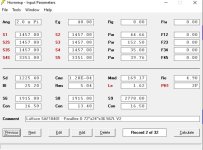Just sim a 3:1 parallel resonator and use L45 to approximate the exit section . There’s nothing too complicated about that design that horn response won’t easily come up with a reasonable simulation even whilst ignoring the slight differences in actual path connections into that last section
HR can't sim well paraflex designs , as far as I know , those designs truly were refined the old fashion way before computers , doing prototypes ... measure...prototype ..measure ....wash .rinse..repeat
I thought the PH functions were specifically designed for Paraflex enclosures?
You can also use the BP8P function to model a Paraflex as long as there are no angles.
This is very strange, as whoever created it didn’t seem to understand what s2 (and s7) are describing in regards to driver position or centerline on the actual cone if stuck at the high pressure ends of these pipes.
but maybe they didn’t care because the distance is so short and high frequency that it doesn’t even affect the bandwidth area ? Their just dumping info into the sim at random and crossing their fingers?
but maybe they didn’t care because the distance is so short and high frequency that it doesn’t even affect the bandwidth area ? Their just dumping info into the sim at random and crossing their fingers?
Attachments
with the TYPE O plan, is it possible to put the info on the HR screen , thing is that somebody who have one cabinet loaded with a driver need to measure and then we can compare, doing it just from the HR side will not tell us nothing until a physical cab can be measured and compared.
This is very strange, as whoever created it didn’t seem to understand what s2 (and s7) are describing in regards to driver position or centerline on the actual cone if stuck at the high pressure ends of these pipes.
but maybe they didn’t care because the distance is so short and high frequency that it doesn’t even affect the bandwidth area ? Their just dumping info into the sim at random and crossing their fingers?
How come the bottom input sections are CON when the top input sections are PAR?
there are fantastic things to discover using the parallel qw resonators based on harmonics. i think this needs to be slightly 'bigger' for the motors to actually fit however.
the more important thing to investigate here is the crazy ringing and potential ‘impulse’ issues at those landmarks however. These things really sh!t the bed (in my experiments with them). It’s really intersting/amazingly awkward to listen to and ‘analyze’.
my paralkel ‘Helmholtz’ stuff sounds so much different and barely has any lengths long enough to stir up any excessive pipe funk. Plus the ‘port’ really helps?
Last edited:
maybe You should join a Facebook group and/or chat where many of us amateur/hobbiest level nerd/geeks discuss these things together (including the members of the high order qw society who design and tweak/tune them to slowly and methodically carve out those issues aa best as possible ?)
Maybe they arent ‘a hit’ in car audio for the same reasons you wouldn’t try to create clear high frequencies with high mms and LE drivers in the first place, let alone use a design that thrived in that area ? So the resonances up top really seem to stick out amongst the mud?
Maybe they arent ‘a hit’ in car audio for the same reasons you wouldn’t try to create clear high frequencies with high mms and LE drivers in the first place, let alone use a design that thrived in that area ? So the resonances up top really seem to stick out amongst the mud?
maybe You should join a Facebook group and/or chat where many of us amateur/hobbiest level nerd/geeks discuss these things together (including the members of the high order qw society who design and tweak/tune them to slowly and methodically carve out those issues aa best as possible ?
Right, so Mark Zuckerberg can make another $72B THIS YEAR.
No, I suck farts out of dead chickens 😝Booger, are you on mushrooms again speaking gibirish ?😆
My ‘opinion’ doesn’t matter. What matters is what the different models really sound like and what interesting things are done to avoid the funky pipe sounds (especially ones that will ring). Those guys took the ‘hardest’ possible type of resonating pipe funk and ’tuned’ it into something lots of people in that PA group seem to enjoy (to put it mildly)If these Paraflex enclosures sound so terrible to you, then why are they such a hit on the net in both the PA and CA worlds?
why do you like to taper your qw pipe into such a small exit over the driver cone? That’s not ‘helping’ anything? Or is it?
There is always the possibility to use series 8th order QW bandpass... 😉and what interesting things are done to avoid the funky pipe sounds (especially ones that will ring)
why do you like to taper your qw pipe into such a small exit over the driver cone? That’s not ‘helping’ anything? Or is it?
Small and low = Hofmann's Iron Law.
Negative taper + >1/3 of Sd mouths = small enclosures that play low, yet they are still more efficient than BR enclosures with lower distortion.
I don't care about high efficiency since I'm not going to be playing my HTS at 120dB 95% of the time.
- Home
- Loudspeakers
- Subwoofers
- 18sound 21LW1400 enclosure
